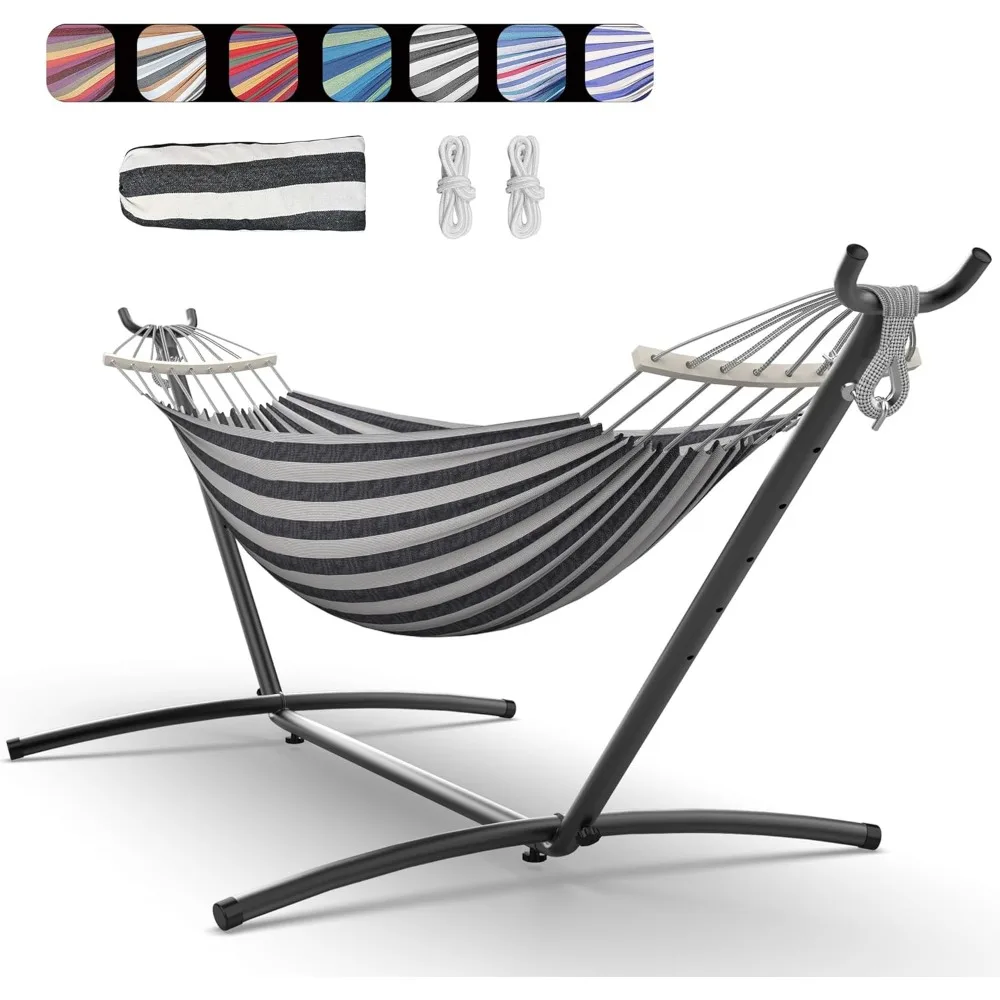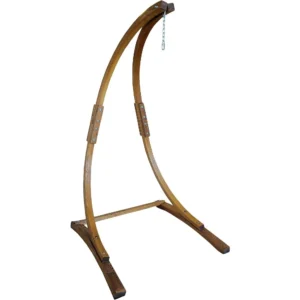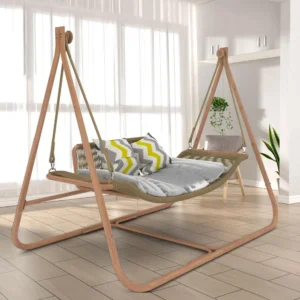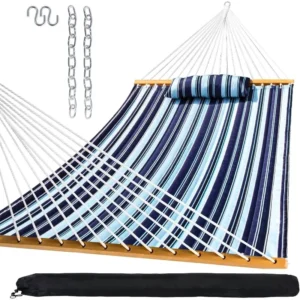Why Double Hammocks Make the Perfect Deck Addition
There’s something magical about transforming your ordinary deck into a personal retreat—a sanctuary where relaxation takes center stage. Double hammocks offer an elegant solution for creating this oasis, combining comfort and style without demanding excessive space. These versatile additions allow you to maximize your outdoor living area while creating a focal point that enhances your deck’s overall appeal.
Unlike bulky furniture sets, two-person hammocks with stands can be positioned to complement your existing deck layout, providing a premium relaxation spot that adjusts to your space constraints rather than dominating them. The beauty of double hammocks lies in their dual functionality—they’re both practical and aesthetically pleasing additions to any outdoor setting.
Perhaps most appealing is the social dimension double hammocks bring to your deck. Whether sharing quiet moments with a partner, lounging with a child for storytime, or simply spreading out for personal comfort, these hammocks create a dedicated space for connection and relaxation. Understanding the proper space requirements for a two-person hammock helps ensure you create a functional and comfortable setup.
In this guide, we’ll walk through everything you need to know about creating your double hammock sanctuary—from planning and selection to installation and accessorizing—to help you transform your deck into the ultimate relaxation destination.
Essential Planning for Your Deck Hammock Installation
Before rushing to install your dream hammock setup, taking time for proper planning ensures a safe, comfortable, and long-lasting retreat. Your deck’s structural integrity serves as the foundation for your hammock sanctuary and deserves careful consideration.
Start by examining your deck’s construction and material:
- Wood decks typically provide good attachment options but require careful hardware selection and regular inspection for rot or weakening.
- Composite decking offers durability but may have different structural considerations than traditional wood.
- Vinyl decks often require specialized installation approaches to prevent damage.
The load-bearing capacity is crucial when planning for a double hammock. Most double hammocks have specific weight limits that must be respected for safety. A typical double hammock requires supports that can handle at least 450-500 pounds (204-227 kg), which includes both the users’ weight and additional forces created during entry, exit, and gentle swinging.
Space requirements are equally important:
– Allow at least 13-15 feet (4-4.6 m) of length for proper hammock hanging with correct sag
– Ensure 4-5 feet (1.2-1.5 m) of width for comfortable entry and exit
– Plan for 18-24 inches (46-61 cm) of clearance beneath the hammock at full weight
Before proceeding with any permanent installation, check your local building codes and HOA restrictions. Some areas have specific requirements regarding deck modifications or may require permits for significant structural changes. This step can save you from costly removal or fines later.
For those needing maximum capacity, exploring heavy-duty hammock options will ensure your setup can handle regular use by multiple people without safety concerns.
Choosing the Perfect Double Hammock for Outdoor Deck Use
Selecting the right hammock style significantly impacts your deck relaxation experience. Each hammock type offers different benefits for outdoor use on your deck:
| Hammock Style | Best For | Durability | Ease of Entry/Exit | Space Requirements |
|---|---|---|---|---|
| Spreader Bar | Flat lounging, easier entry/exit | Good | Excellent | Wide clearance needed |
| Brazilian | Traditional comfort, deeper cocoon | Excellent | Moderate | Less width required |
| Quilted | Added padding, cooler weather | Very Good | Good | Medium clearance |
| Rope | Traditional look, airflow | Good (with maintenance) | Challenging | Similar to Brazilian |
Material selection is crucial for outdoor hammocks. Look for weather-resistant fabrics like solution-dyed acrylic (similar to Sunbrella), polyester, or properly treated cotton blends. UV-resistant materials prevent fading and deterioration from sun exposure, while quick-drying properties prevent mold and mildew issues after rain.
Different hammock fabrics offer varying levels of comfort and durability, with synthetic options typically providing better weather resistance for permanent outdoor installations. The most comfortable hammocks often blend durability with soft-touch fabrics that resist becoming abrasive after exposure to elements.
Weight capacity should be considered with a generous safety margin. While many standard double hammocks support 400-450 pounds (181-204 kg), choosing one rated for 550+ pounds (250+ kg) provides peace of mind and accommodates unexpected situations like an extra child or pet joining you.
When browsing double hammock options, consider your deck’s aesthetic as well. Choose colors and patterns that complement your existing outdoor decor for a cohesive look that enhances your outdoor living space.
Double Hammock Stand Options for Deck Installations
Freestanding hammock stands offer the most versatile solution for deck installations, requiring no permanent modifications while providing stable support. These stands come in various materials and styles to complement your deck aesthetic.
Material options include:
- Steel stands – Offer maximum stability and weight capacity, typically powder-coated for weather resistance
- Aluminum stands – Lightweight and naturally corrosion-resistant, easier to move but may have lower weight limits
- Wooden stands – Provide natural aesthetic appeal that complements deck materials, require more maintenance
When positioning a stand on your deck, consider both the stand’s footprint and the full extension of the hammock. Most double hammock stands require approximately 15 feet (4.6 m) of length and 4 feet (1.2 m) of width. Allow additional clearance space around the setup for safe entry and exit.
Stability is a critical concern for deck-based stands. Consider these measures to enhance stability:
– Use rubber or silicone feet to prevent sliding and protect deck surfaces
– Position the stand perpendicular to deck boards rather than parallel when possible
– Add weight bags to stand bases in windy locations
– Ensure the deck surface is level before assembly
For seasonal or occasional use, portable hammock stand options provide flexibility to reclaim deck space when needed. Look for models with tool-free assembly or quick-disconnect features for convenient setup and takedown.
If your hammock stand feels unstable during use, implementing techniques for stabilizing a double hammock stand can significantly improve the safety and comfort of your setup.
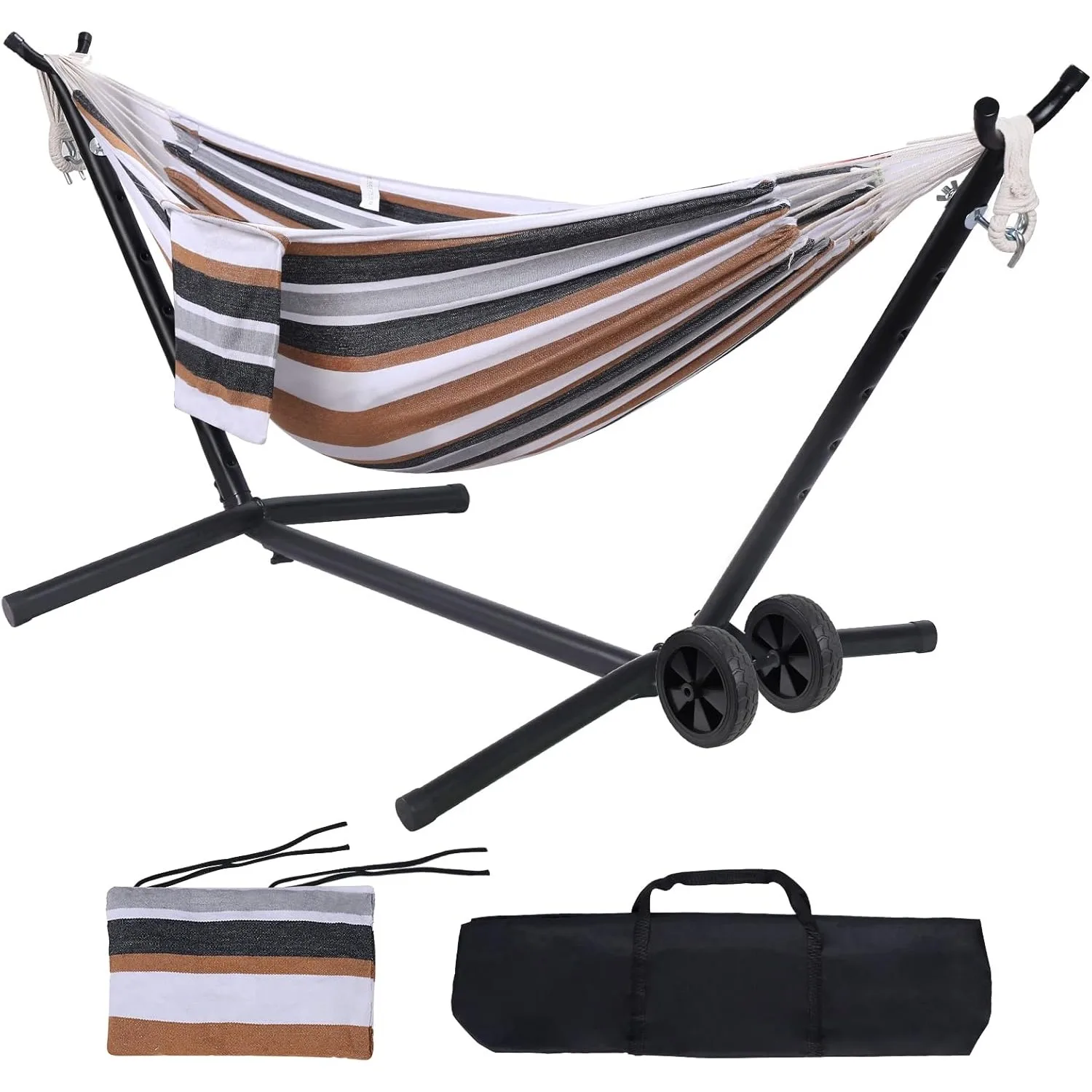
Attaching Double Hammocks to Existing Deck Structures
If your deck features pergolas, gazebos, or robust posts, these structures may provide ideal attachment points for your hammock. Before using existing features, carefully assess their structural capacity and condition.
When evaluating potential attachment points:
– Check for signs of rot, splitting, or weakness in wooden structures
– Ensure posts are properly secured to the deck frame and not just the decking surface
– Verify that the structure can support lateral (side-to-side) forces, not just vertical weight
For secure attachment, use appropriate hardware:
1. Choose stainless steel eye bolts rated for at least 500 pounds (227 kg)
2. Drill pilot holes slightly smaller than the bolt diameter to prevent splitting
3. Use backing plates on the opposite side of wooden posts for added strength
4. Apply silicone sealant around hardware installations to prevent water infiltration
Common mistakes to avoid include:
– Attaching to decorative railings not designed for lateral loads
– Using undersized hardware that can fail under dynamic weight
– Failing to account for wood movement and weathering over time
In cases where existing structures appear suitable but might need reinforcement, consider installing additional bracing or sister supports before adding your hammock. For complete hammock solutions that work with various attachment methods, explore quality hammock and stand combinations designed for versatile installation.
Installing Dedicated Posts for Your Double Hammock
When your deck lacks suitable existing structures for hammock attachment, installing dedicated posts offers a permanent, stable solution. This approach works particularly well for large decks or situations where you want to position your hammock in a specific location.
Post material considerations:
– 6×6 inch (15×15 cm) pressure-treated lumber provides optimal stability for most installations
– Cedar or redwood offers natural decay resistance with aesthetic appeal
– Steel posts provide maximum strength but require specific mounting hardware
For through-deck installation (recommended method):
1. Locate your deck’s structural framing using an inspection camera or access from below
2. Position posts to align with and attach to structural joists or beams, not just decking
3. Use carriage bolts or through-bolts (½ inch/13 mm diameter minimum) to secure posts
4. Install diagonal bracing for lateral stability
5. Add decorative caps or finials to enhance appearance
For ground-set posts adjacent to your deck:
1. Dig footing holes below the frost line (typically 36-48 inches/91-122 cm deep)
2. Pour concrete footings with J-bolts or use post brackets
3. Attach posts securely to footings
4. Install cross-bracing between posts for stability
Proper post spacing for double hammocks should be 14-16 feet (4.3-4.9 m) apart, depending on your hammock’s length. Weather protection is essential—apply exterior-grade sealant or stain to wooden posts annually and check hardware for signs of corrosion.
When selecting materials for your permanent installation, consider options that offer the strongest materials for hammock stands to ensure years of safe enjoyment.
Wall-Mounted Solutions for Deck-Adjacent Hammocks
For decks that adjoin your home, wall-mounted supports provide a space-efficient alternative that reduces the need for freestanding structures. This approach works particularly well for smaller decks where maximizing usable space is a priority.
To identify proper wall anchor points:
– Use a stud finder to locate wall studs (typically spaced 16 inches/41 cm apart)
– Mark stud centers clearly with tape or pencil
– Verify stud locations with a small test drill or deep-sensing stud finder
Appropriate hardware selection is critical:
– For wood-framed walls, use heavy-duty eye bolts with lag threads at least 4 inches (10 cm) long
– For masonry walls, use expansion bolts or epoxy anchors rated for outdoor use
– Always choose stainless steel or hot-dipped galvanized hardware for corrosion resistance
When mounting to exterior walls, protect your home’s weather barrier:
– Apply silicone sealant around all penetrations
– Use rubber gaskets between hardware and wall surfaces
– Position mounts to prevent water pooling
Mount your wall hardware at 5-7 feet (1.5-2.1 m) above the deck surface for optimal hammock hanging angle. Ensure the opposite support point (post or second wall mount) allows for proper hammock sag.
For a cohesive look that complements your deck design, consider wooden hammock stand options that can be used in combination with a single wall mount for a hybrid installation approach.
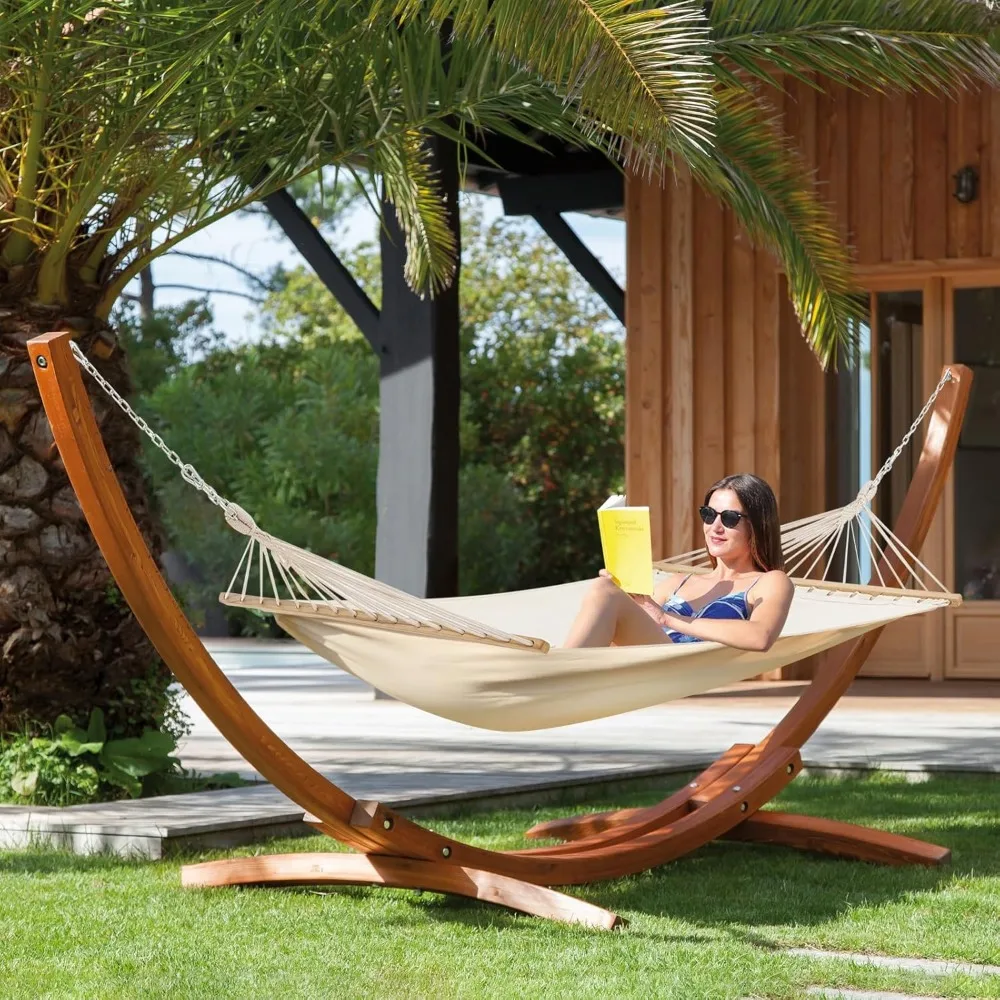
Essential Hardware for Secure Double Hammock Installation
Selecting appropriate hardware ensures both safety and longevity for your hammock setup. This checklist covers essential components for various installation methods:
Basic hardware requirements:
– Hammock hanging hooks or eye bolts (stainless steel, minimum 500-pound/227 kg rating)
– Heavy-duty carabiners or S-hooks (stainless steel, minimum 1,000-pound/453 kg rating)
– Hammock straps or chains (weather-resistant, UV-protected)
– Hanging hardware appropriate to your installation method
For wooden installations:
– Lag eye bolts (½ inch/13 mm diameter minimum)
– Backing plates for through-bolt installations
– Exterior-grade wood screws for bracing
– Waterproof sealant for hardware penetrations
For stand installations:
– Stand-specific assembly hardware (typically included)
– Surface protectors for deck contact points
– Stand stabilizer accessories if needed
Required tools typically include:
– Drill with appropriate bits for your deck material
– Wrenches or socket set for hardware tightening
– Level for ensuring proper alignment
– Stud finder for wall installations
– Measuring tape for accurate positioning
Establish a regular hardware inspection routine—check all components at the start of each season and periodically throughout heavy use periods. Look for signs of corrosion, bending, or wear that could compromise safety.
For comfortable hammock options that include appropriate hanging hardware, browse fabric hammock sets designed for outdoor use.
Critical Safety Checks for Your Deck Hammock Setup
Safety should remain your top priority with any hammock installation. Following these key principles ensures your hammock sanctuary remains a source of relaxation rather than risk.
The 30-degree hang angle rule serves as the foundation of safe hammock setup. When occupied, your hammock should form approximately a 30-degree angle from horizontal at each suspension point. This angle provides optimal stability, comfort, and reduces stress on attachment points.
For proper height settings:
– Position the bottom of your empty hammock 18-24 inches (46-61 cm) above the deck surface
– Allow for 12-18 inches (30-46 cm) of sag when occupied
– Ensure hammock ends are 4-5 feet (1.2-1.5 m) above the deck for proper entry height
Develop a regular inspection routine:
1. Check all hardware for signs of corrosion or loosening monthly
2. Inspect hammock fabric for wear, fraying, or UV damage
3. Test attachment points by applying gentle pressure before each use
4. Examine wooden components for splitting, cracking, or rot
5. Verify stability of stands or posts with gentle rocking before full weight loading
Respect weight limits by knowing your hammock’s specific capacity and never exceeding 80% of the stated maximum for safety margin. Be especially cautious during entry and exit, as these moments create the highest stress on your setup.
Understanding the benefits of quality double hammocks helps you appreciate the importance of these safety measures in maximizing your enjoyment.
Strategic Placement and Layout for Deck Hammock Zones
Thoughtful positioning of your hammock transforms it from a simple addition to a centerpiece of your deck’s design. Consider these factors when determining placement:
Environmental considerations:
– Morning vs. afternoon sun exposure based on your preference
– Prevailing wind patterns for natural cooling
– Privacy from neighbors or street view
– Scenic views or focal points to enhance relaxation
Create intentional traffic patterns around your hammock zone by positioning it away from high-traffic pathways. Allow at least 3 feet (91 cm) of clearance on all sides for safe movement around the hammock when occupied.
For smaller decks, consider these space-optimizing strategies:
– Corner installations that utilize otherwise awkward spaces
– Removable or folding stand options that can be stowed when not in use
– Wall-mounted solutions that minimize footprint
– Multi-functional elements (like storage benches that double as hammock supports)
When integrating your hammock with existing deck elements, create conversation zones by positioning comfortable seating within easy conversational distance of the hammock. Add small side tables within reach of the hammock for beverages, books, or electronic devices.
For comprehensive guidance on creating the perfect environment, explore ideas for creating the perfect hammock haven that complements your unique deck space.
Must-Have Accessories for the Ultimate Hammock Experience
Elevate your hammock sanctuary from basic to extraordinary with carefully selected accessories that enhance comfort, convenience, and ambiance.
Comfort enhancements:
– Weather-resistant throw pillows in complementary colors
– Dedicated hammock pillows designed for proper neck support
– Lightweight outdoor blankets for cooler evenings
– Hammock pad inserts for additional cushioning
Shade solutions:
– Adjustable canopy attachments that move with the sun
– Freestanding umbrellas positioned for optimal coverage
– Pergola curtains that filter light while maintaining airflow
– Retractable shade sails for flexible protection
Evening atmosphere creators:
– Solar-powered string lights hung overhead
– Weatherproof Bluetooth speakers for ambient sound
– LED candles in weather-resistant holders
– Tabletop fire features (where permitted by local codes)
Convenience additions:
– Side tables at hammock height for beverages and books
– Storage solutions for hammock accessories
– Quick-dry hammock towels for post-swim relaxation
– Cup holders or device pockets that attach directly to hammock edges
For integrated relaxation solutions that combine multiple features, consider hammock options with built-in canopies that provide both comfort and shade in one package.
Dark Wood Hammock Sets, Porch Swing Chair Sets
$653.82 Select options This product has multiple variants. The options may be chosen on the product pageA-Frame Stand Hammock Sets, Swinging Hammock Chair Sets
$154.62 Select options This product has multiple variants. The options may be chosen on the product pageLight Wood Hammock Sets, Swinging Hammock Chair Sets
$1,359.35 Select options This product has multiple variants. The options may be chosen on the product pageClassic Wooden Stand Hammock Sets, Heavy Duty Hammock Sets
$1,061.68 Select options This product has multiple variants. The options may be chosen on the product pageHammock Sets with Canopy, Heavy Duty Hammock Sets
$286.31 Select options This product has multiple variants. The options may be chosen on the product page
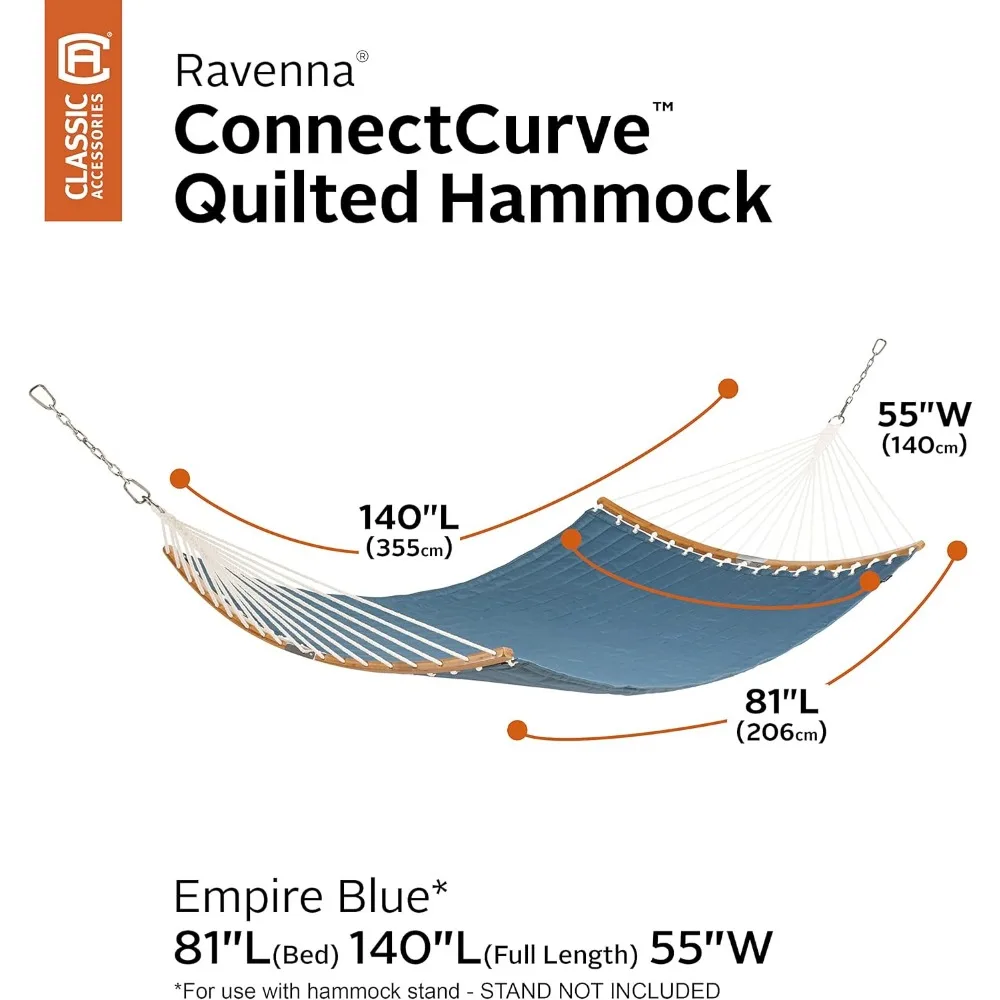
Solving Common Double Hammock Setup Challenges
Even the most thoughtfully planned hammock installations can face challenges. Here are practical solutions to common issues:
Challenge: Deck without suitable attachment points
Solution: Use a freestanding hammock stand specifically designed for deck placement, with non-slip feet to prevent movement. Alternatively, create a hybrid system using a single post combined with a wall mount.
Challenge: Uneven deck surface
Solution: Add adjustable feet to hammock stands or use shims under stand legs to create a level foundation. For permanent posts, ensure they’re installed plumb regardless of deck surface variations.
Challenge: Protecting deck surfaces
Solution: Place rubber mats or outdoor rugs under hammock stands to prevent scratching. For permanent installations, use metal post bases with gaskets to create a moisture barrier between wood and decking.
Challenge: Weather concerns
Solution: Implement a quick-release hanging system that allows for fast hammock removal during severe weather. Store indoor-outdoor hammocks in weatherproof bags when not in use for extended periods.
Challenge: Limited seasonal use
Solution: Create a dedicated storage solution for your hammock during off-seasons, including proper cleaning before storage and moisture-controlling elements in storage containers.
Many people wonder if double hammocks are truly worth the investment when facing these challenges, but with proper planning and these solution strategies, the benefits far outweigh the initial setup considerations.
DIY Hammock Stand Projects for Your Deck
Creating your own hammock stand offers both cost savings and the satisfaction of a custom solution perfectly tailored to your deck. Here are two approachable DIY options:
Simple A-Frame Wooden Stand
Materials:
– Four 4×4 inch (10×10 cm) pressure-treated posts, 8 feet (2.4 m) long
– Two 2×6 inch (5×15 cm) pressure-treated boards, 8 feet (2.4 m) long
– Galvanized carriage bolts (½ inch/13 mm) with washers and nuts
– Stainless steel eye bolts (⅜ inch/10 mm)
– Weather-resistant wood finish
Basic construction:
1. Create two A-frames by joining posts at the top with carriage bolts
2. Connect the A-frames with 2×6 boards as base supports
3. Install eye bolts near the top of each A-frame for hammock attachment
4. Apply weather-resistant finish to all wood surfaces
Metal Pipe Stand
Materials:
– 1½ inch (3.8 cm) galvanized pipe, approximately 20 feet (6.1 m) total
– Pipe fittings (T-joints, elbows, flanges)
– Concrete blocks or deck attachment hardware
– Spray paint designed for metal surfaces
Basic construction:
1. Create a rectangular base using pipes and T-joints
2. Add vertical supports at each end with elbow fittings
3. Install horizontal crossbars for hammock attachment
4. Secure to deck with flanges or stabilize with concrete blocks
5. Apply protective paint finish
Both projects can be customized to match your deck aesthetics through finish selection and decorative elements. Always prioritize structural integrity by ensuring all connections are secure and components are properly rated for the intended weight capacity.
For design inspiration, consider the features that make freestanding hammocks comfortable for couples and incorporate these elements into your DIY project.
Maintenance Tips for Long-Lasting Deck Hammock Enjoyment
Proper maintenance extends the life of your hammock setup and ensures continued safe enjoyment throughout the seasons. Follow these care guidelines based on your specific hammock materials:
Fabric Hammock Care:
– Remove debris regularly with gentle brushing
– Clean with mild soap and water as needed, avoiding harsh chemicals
– Allow to dry completely before storage or reuse
– Apply fabric protectant designed for outdoor use annually
Hardware Maintenance:
– Inspect all connection points monthly during the use season
– Tighten any loose hardware promptly
– Check for signs of corrosion or metal fatigue
– Apply rust inhibitor to non-stainless hardware annually
Stand or Support Care:
– Clean wooden components with appropriate deck cleaner annually
– Apply fresh water-resistant sealer to wooden elements as recommended
– Touch up any paint or finish damage on metal components
– Check for and repair any loose connections immediately
Seasonal Storage Recommendations:
– Clean and thoroughly dry hammock before storage
– Store in breathable bag in a dry location
– Remove fabric hammock from outdoor frames during extended non-use periods
– Cover permanent stands with breathable, waterproof covers during off-season
Address emerging issues promptly—small tears become larger with use, and minor corrosion can quickly compromise structural integrity. By choosing quality hammocks designed for couples, you’ll often enjoy reduced maintenance requirements and greater longevity.
Your Questions Answered: Double Hammock Deck FAQs
How do I protect my hammock from weather damage?
Opt for weather-resistant materials like solution-dyed acrylic, polyester, or specially treated cotton. Use a hammock cover during brief periods of non-use and remove the hammock entirely during extended bad weather or seasonal changes.
Can I install a hammock without permanently modifying my deck?
Absolutely. Freestanding hammock stands provide stable support without requiring permanent attachments. Look for stands with rubber feet to prevent sliding and protect your deck surface. Some stands can even be weighted down rather than attached for additional stability.
How much maintenance does a deck hammock require?
Regular maintenance is fairly minimal—inspect hardware monthly, clean fabric as needed with mild soap and water, and check stands for stability before each use. More thorough cleaning and preservation (like wood sealing or metal rust prevention) should be done seasonally.
Is it safe to leave my hammock outside year-round?
While many hammocks are designed for outdoor use, continuous exposure to elements will shorten their lifespan. In regions with harsh winters or intense sun, seasonal storage of the fabric portion is recommended, even if the stand remains in place.
How do I stabilize a hammock stand that wobbles on my deck?
Add rubber non-slip pads under stand feet, position the stand perpendicular to deck boards rather than parallel, ensure the surface is level, and consider adding sandbags or other weights to the base for additional stability.

